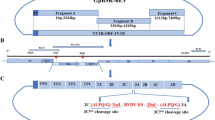Summary
A pestivirus was transmitted by contact from a persistently infected (P.I.) bullock to pregnant sheep. This resulted in the birth of EI. lambs, one of which in turn was able to transmit virus by contact to pregnant cattle. Two of these animals gave birth to EI. calves, from one of which the virus was again transmitted by contact with pregnant sheep, leading to another generation of EI. lambs. The expression of one or more epitopes on the E2 glycoprotein of the viruses isolated from this series of alternate cattle-sheep transmissions appeared to depend on the host species. Thus, several monoclonal antibodies which bound strongly to, and neutralised, viruses isolated from the bovine hosts, failed to bind or neutralise in the case of sheep isolates. The viral consensus sequences of the E2 gene as well as parts of the 5’ untranslated region and of the NPro and capsid genes were compared between the different isolates. This revealed a high degree of genetic stability. However, a single codon change at amino acid position 9 of the E2 gene correlated with and was able to cause the loss of particular epitopes.
Similar content being viewed by others
References References
Collett MS, Larson R, Gold C, Strick D, Anderson DK, Purchio AF (1988) Molecular cloning and nucleotide sequence of the pestivirus bovine viral diarrhea virus. Virology 165:191–199
Domingo E, Diez J, Martinez MA, Hernandez J, Holguin A, Borrego B, Mateu MG (1993) New observations on antigenic diversification of RNA viruses. Antigenic variation is not dependent on immune selection. J Gen Virol 74: 2 039–2 045
Edwards S, Sands JJ, Harkness J (1988) The application of monoclonal antibody panels to characterize pestivirus isolates from ruminants in Great Britain. Arch Virol 102:197–206
Meier Ph, Frech B, Adler H, Stalder HP, Peterhans E (1994) Adaptation of bovine viral diarrhea virus to cultured cells is associated with mutations in the major surface glycoprotein E2. Abstracts of the 3rd Congress of the European Society for Veterinary Virology, Interlaken, Switzerland, 4-7 September 1994 P4-5
Nettleton PF, Gilmour JS, Herring JA, Sinclair JA (1992) The production and survival of lambs persistently infected with border disease virus. Comp Immunol Microbiol Infect Dis 15: 179-188
Paton DJ (1992) Bovine viral diarrhoea virus: studies of viral epitopes and of porcine infections. PhD Thesis, University of Surrey
Paton DJ, Lowings JPL, Barrett A (1992) Epitope mapping of the gp53 envelope protein of bovine viral diarrhoea virus. Virology 190: 763-772
Paton DJ, Done SH (1994) Congenital infection of pigs with ruminant-type pestivirus. J Comp Pathol 111: 151-163
Paton DJ, Lowings JP, Ramirez G (1994) Stability of the gp53 gene of bovine viral diarrhoea virus on passage in a persistently infected steer. Br Vet J 150: 603-607 10. Paton DJ (1995) Pestivirus diversity. J Comp Pathol 112: 215-236
Paton DJ, Sands JJ, Lowings JP, Smith JE, Ibata G, Edwards S (1995a) A proposed division of the pestivirus genus using monoclonal antibodies, supported by crossneutralisation assays and genetic sequencing. Vet Res 26: 92-109
Paton DJ, Carlsson U, Lowings JP, Sands JJ, Vilcek S, Alenius S (1995b) Identification of herd-specific bovine viral diarrhoea virus isolates from infected cattle and sheep. Vet Microbiol 43: 283-294
Pellerin C, van den Hurk J, Lecomte J, Tijssen P (1994) Identification of a new group of bovine viral diarrhea virus strains associated with severe outbreaks and high mortalities. Virology 203: 260-268
Renard A, Dina D, Martial JA (1987) Vaccines and diagnostics derived from bovine viral diarrhea virus. European Patent Application no 86870095.6. Publication no. 0208672, 14 January 1987
Stalder HP, Hertig Chr, Peterhans E (1994) Genetic heterogeneity of bovine viral diarrhea virus and evolutionary stasis in immunotolerant animals. Abstracts of the 3rd Congress of the European Society for Veterinary Virology, Interlaken, Switzerland, 47 September 1994 P4-1
van Doom L -J, Capriles I, Maertens G, DeLeys R, Murray K, Kos T, Scellekens H, Quint W (1995) Sequence evolution of the hypervariable region in the putative envelope region E2/NS1 of hepatitis C virus is correlated with specific humoral immune responses. J Virol 69: 773–778
Vilcek S, Herring AJ, Herring JA, Nettleton PF, Lowings JPL, Paton DJ (1994) Pestiviruses isolated from pigs, cattle and sheep can be allocated into at least three genogroups using polymerase chain reaction and restriction endonuclease analysis. Arch Virol 136: 309–323
Vilcek S, Nettleton PF, Paton DJ, Belak S (1997) Molecular characterization of ovine pestiviruses. J Gen Virol 78 (in press)
Xue W, Minocha HC (1993) Identification of the cell surface receptor for bovine viral diarrhoea virus by using anti-idiotypic antibodies. J Gen Virol 74: 73–79
Author information
Authors and Affiliations
Rights and permissions
About this article
Cite this article
Paton, D., Gunn, M., Sands, J. et al. Establishment of serial persistent infections with bovine viral diarrhoea virus in cattle and sheep and changes in epitope expression related to host species. Arch. Virol. 142, 929–938 (1997). https://doi.org/10.1007/s007050050129
Received:
Accepted:
Published:
Issue Date:
DOI: https://doi.org/10.1007/s007050050129




